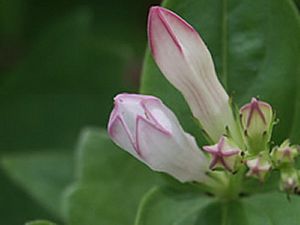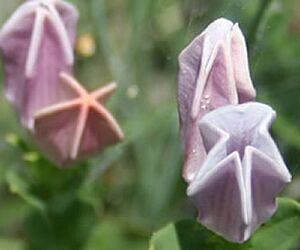Purpleflower pinkroot facts for kids
Quick facts for kids Purpleflower pinkroot |
|
|---|---|
 |
|
| Conservation status | |
| Scientific classification | |
| Genus: |
Spigelia
|
| Species: |
gentianoides
|
Spigelia gentianoides is a special flowering plant. It is often called the purpleflower pinkroot or gentian pinkroot. This plant is very rare. It only grows in a few small areas in Alabama and Florida in the United States. Because there are so few of them, it is an endangered species. This means it is protected by law.
Contents
What Does the Purpleflower Pinkroot Look Like?
This plant is a perennial herb. This means it lives for more than two years. It grows a thin, straight stem that can be up to 30 centimeters (about 12 inches) tall. The stem often has a reddish color. It grows from a special underground stem called a rhizome.
The leaves grow in pairs on opposite sides of the stem. Each leaf can be up to 5 centimeters (about 2 inches) long and 2 centimeters (about 0.8 inches) wide.
The flowers grow in a cluster at the top of the stem. This cluster is called a raceme. Each flower has a pink, tube-shaped part called a corolla. It can be up to 3 centimeters (about 1.2 inches) long. The corolla has five triangle-shaped tips. These plants usually bloom from May to July. However, you might see them flowering from April all the way to October.
Where Does This Plant Grow?
Spigelia gentianoides likes to grow in wooded areas. These areas have many trees. Some common trees where it grows include loblolly pine, longleaf pine, water oak, laurel oak, southern red oak, and black tupelo.
In Alabama, it also grows in special rocky areas. These areas are called dolomite glades.
Different Kinds of Purpleflower Pinkroot
There are two main types, or varieties, of S. gentianoides.
One type is called var. alabamensis. This variety is only found in Bibb County, Alabama. It grows in a place called the Bibb County Glades. This area has more different kinds of plants and animals than almost anywhere else in Alabama. This is called high biodiversity.
The other type is called var. gentianoides. This one grows in southern Alabama and the Florida Panhandle. There are only five groups of these plants left. The two biggest groups are in Jackson County. The third largest group is in the Geneva State Forest in Alabama.
The main difference between these two varieties is how their flowers look. The flowers of var. alabamensis open up more when they are fully bloomed. The flowers of var. gentianoides stay more tube-shaped.
Why Is This Plant in Danger?
The purpleflower pinkroot faces several threats. These are things that make it harder for the plant to survive.
- Logging: When forests are cut down for wood, the plant loses its home.
- Fire Suppression: Some plants need natural fires to help them grow. When fires are stopped, it can harm the plant's habitat.
- Overcollection: Sometimes people collect too many of these rare plants. This makes it even harder for them to survive in the wild.
- Pine Plantations: Land is sometimes cleared to plant rows of pine trees. This is called Silviculture. It destroys the plant's natural habitat.
- Quarrying: In Alabama, the plant is threatened by quarrying. This is when rocks are dug out of the ground.
Helping the Plant Survive
Scientists and conservationists are working to protect the purpleflower pinkroot.
One way to help is through controlled burns. These are small, planned fires. They can help the plant grow more. However, if fires happen too often, they can actually hurt the plant. It's a careful balance to keep the plant safe.



